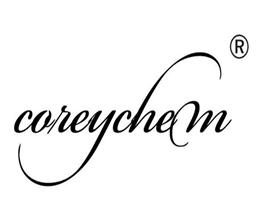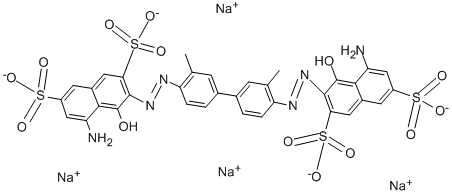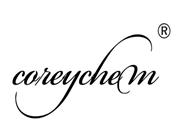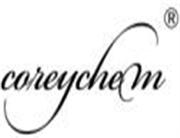| Chemical Properties |
blueish grey powder |
| Chemical Properties |
Trypan Blue is a dark Blue crystalline solid or powder. |
| Uses |
Biological stain. |
| Definition |
ChEBI: An organosulfonate salt that is the tetrasodium salt of 3,3'-[(3,3'-dimethylbiphenyl-4,4'-diyl)didiazene-2,1-diyl]bis(5-amino-4-hydroxynaphthalene-2,7-disulfonic acid). |
| General Description |
Bluish-gray to dark blue powder. |
| Air & Water Reactions |
Azo dyes can be explosive when suspended in air at specific concentrations. Slightly soluble in water. |
| Reactivity Profile |
Direct Blue 14 is an azo compound. Azo, diazo, azido compounds can detonate. This applies in particular to organic azides that have been sensitized by the addition of metal salts or strong acids. Toxic gases are formed by mixing materials of this class with acids, aldehydes, amides, carbamates, cyanides, inorganic fluorides, halogenated organics, isocyanates, ketones, metals, nitrides, peroxides, phenols, epoxides, acyl halides, and strong oxidizing or reducing agents. Flammable gases are formed by mixing materials in this group with alkali metals. Explosive combination can occur with strong oxidizing agents, metal salts, peroxides, and sulfides. Direct Blue 14 is incompatible with strong oxidizing agents and strong acids. |
| Health Hazard |
ACUTE/CHRONIC HAZARDS: Direct Blue 14 may cause irritation and may be absorbed through the skin. It is a positive animal carcinogen. When heated to decomposition Direct Blue 14 emits very toxic fumes of nitrogen oxides, sulfur oxides, carbon monoxide and carbon dioxide. |
| Fire Hazard |
Flash point data for Direct Blue 14 are not available; however, Direct Blue 14 is probably combustible. |
| Safety Profile |
Suspected carcinogen with experimental carcinogenic, neoplastigenic, and tumorigenic data. Poison by intraperitoneal, intravenous, and subcutaneous routes. Experimental teratogenic and reproductive effects. Mutation data reported. When heated to decomposition it emits very toxic fumes of NOx NazO, and SOx |
| Potential Exposure |
Used in dyeing textiles; leather and paper; as a biological stain. |
| First aid |
If this chemical gets into the eyes, remove any contact lenses at once and irrigate immediately for at least 15 minutes, occasionally lifting upper and lower lids. Seek medical attention immediately. If this chemical contacts the skin, remove contaminated clothing and wash immediately with soap and water. Seek medical attention immediately. If this chemical has been inhaled, remove from exposure, begin rescue breathing (using universal precautions, including resuscitation mask) if breathing has stopped and CPR if heart action has stopped. Transfer promptly to a medical facility. When this chemical has been swallowed, get medical attention. Give large quantities of water and induce vomiting. Do not make an unconscious person vomit. |
| Shipping |
UN2811 Toxic solids, organic, n.o.s., Hazard Class: 6.1; Labels: 6.1-Poisonous materials, Technical Name Required. UN3143 dyes, solid, toxic, n.o.s. or dye intermediates, solid, toxic, n.o.s., Hazard Class: 6.1; Labels: 6.1-Poisonous materials, Technical Name Required. |
| Incompatibilities |
Dust may form explosive mixture with air. Trypan Blue is incompatible with strong oxidizing agents. Incompatible with oxidizers (chlorates, nitrates, peroxides, permanganates, perchlorates, chlorine, bromine, fluorine, etc.); contact may cause fires or explosions. Keep away from alkaline materials, strong bases, strong acids, oxoacids, epoxides. Azo compounds can detonate. This applies in particular to organic azides that have been sensitized by the addition of metal salts or strong acids. Toxic gases are formed by mixing materials of this class with acids, aldehydes, amides, carbamates, cyanides, inorganic fluorides, halogenated organics, isocyanates, ketones, metals, nitrides, peroxides, phenols, epoxides, acylhalides, and strong oxidizing or reducing agents. Flammable gases are formed by mixing materials in this group with alkali metals. Explosive combinations can occur with strong oxidizing agents, metal salts, peroxides, and sulfides. Trypan Blue is sensitive to prolonged exposure to heat. |
| Waste Disposal |
Consult with environmental regulatory agencies for guidance on acceptable disposal practices. Generators of waste containing this contaminant (≥100 kg/mo) must conform with EPA regulations governing storage, transportation, treatment, and waste disposal. |

 China
China







